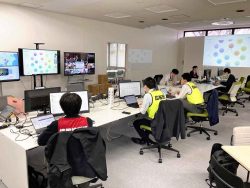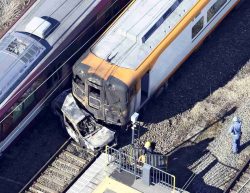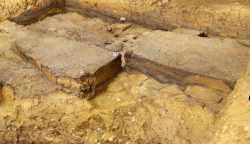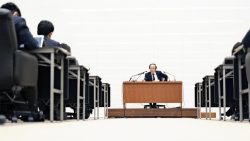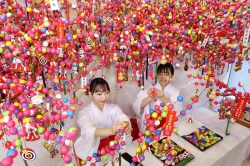Late Nihon Hidankyo Head Tirelessly Conveyed Horror of A-Bombing; Nobel Prize Highlights Global Impact of Group
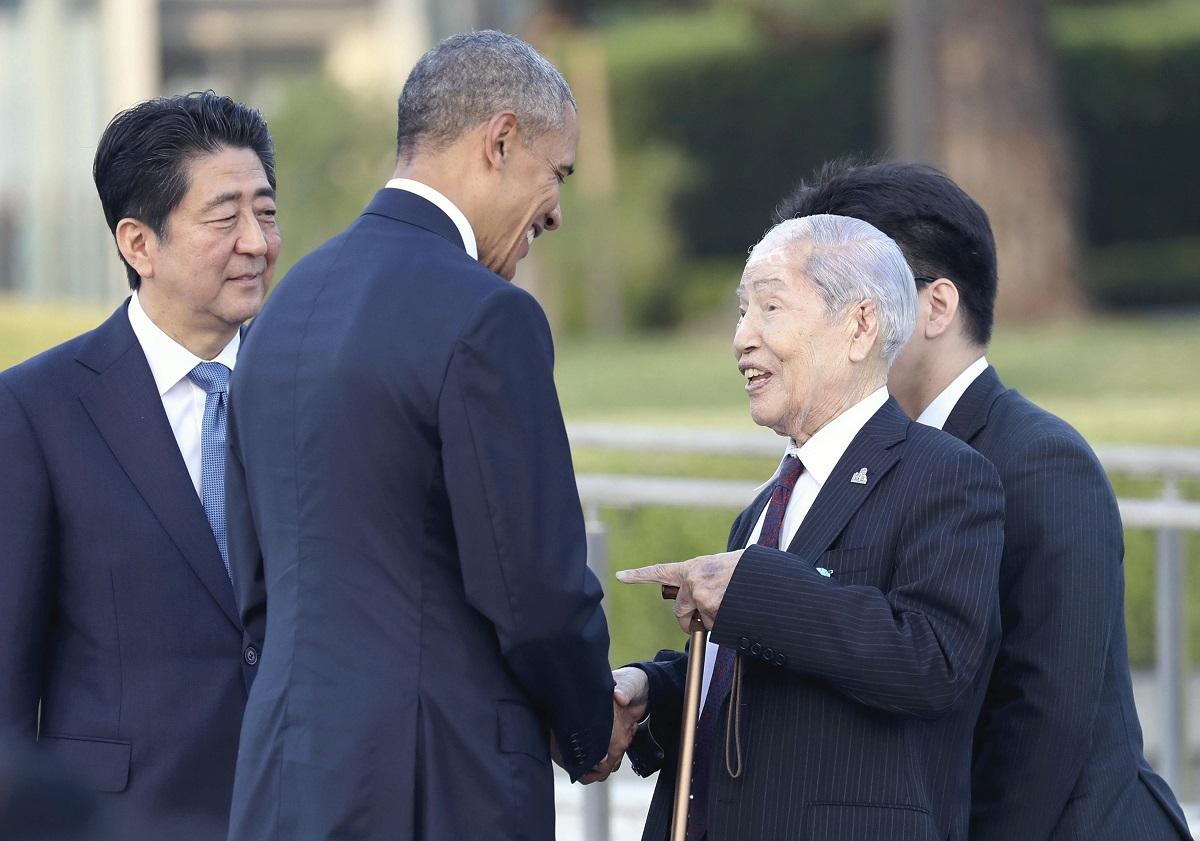
Sunao Tsuboi, second from right, talks with then U.S. President Barack Obama and then Prime Minister Shinzo Abe, left, at Peace Memorial Park in Hiroshima in May 2016.
16:30 JST, October 12, 2024
HIROSHIMA — Sunao Tsuboi tirelessly conveyed the voices of hibakusha to the world as both the face of the atomic-bombed city of Hiroshima and the chairperson of Nihon Hidankyo, or Japan Confederation of A- and H-Bomb Sufferers Organizations, until he passed away in 2021 at the age of 96.
Tsuboi was 20 when he was injured in the atomic bombing at a location 1.2 kilometers away from the hypocenter. He passed out immediately after inscribing the words: “Tsuboi, here I die” on the ground with a stone. He was left with severe burns all over his body.
After the atomic bombing, Tsuboi became a junior high school teacher. His efforts to convey his experience as a hibakusha and the horrific nature of nuclear weapons earned him the nickname “Pika-don sensei.” Pika-don is a Japanese word that describes the intense flash of light from an atomic blast and the strong shock wave that follows.
He assumed the post of Nihon Hidankyo chairperson in 2000 and led the campaign for the abolition of nuclear weapons at international conferences and other forums. When Barack Obama visited Hiroshima in May 2016, Tsuboi spoke to the then U.S. president, saying, “Next time you come back to the city, I hope you will take the time to listen to the stories of hibakusha.”
“Winning the award will mean nothing if a third nuclear weapon is used,” said Masanori Ueda, 92, of Kure, Hiroshima Prefecture, who worked with Tsuboi for many years as vice chairperson of the Hiroshima Prefectural Confederation of A-Bomb Sufferers Organization. “Mr. Tsuboi would probably say, ‘Do everything you can until the day the abolition of nuclear weapons becomes a reality.’”
In Nakagawa, Fukuoka Prefecture, Masahiro Sasaki, 83, was in front of the Buddhist altar at his home, saying: “Sadako, I’m happy for you. Your hope for peace has reached more people.”
His younger sister Sadako was the model for the Children’s Peace Monument, a statue in Hiroshima’s Peace Memorial Park. Sadako was just 2 when she was exposed to the radiation of the bomb while at her home. She died in October 1955 at the age of 12, suffering from leukemia. Wishing for her recovery, she continued to make paper cranes on her sickbed until her death. Her life story has been told through books and films both in Japan and abroad.
“The world has come to recognize the suffering of hibakusha and the horror of the atomic bombings, which Nihon Hidankyo has conveyed through its persistent efforts,” Sasaki said after learning of Friday’s news.
“On behalf of the A-bombed city of Hiroshima, I want to offer my heartfelt congratulations,” Hiroshima Mayor Kazumi Matsui told reporters on Friday, after the Peace Prize was announced.
The International Signature Campaign in Support of the Appeal of the Hibakusha for the Elimination of Nuclear Weapons was launched in 2016 by A-bomb survivors and others.
Referring to the campaign, Matsui said, “The collection of signatures from more than 13.7 million people was a driving force behind the enactment of the Treaty on the Prohibition of Nuclear Weapons and its entry into force.”
Nagasaki Mayor Shiro Suzuki, whose parents survived the Nagasaki atomic bombing, held a press conference at the Nagasaki city government’s building.
“With the average age of hibakusha now over 85, the question of how to pass on their efforts to the next generation is an important one. I hope winning the Nobel Peace Prize will become a major driving force for the elimination of nuclear weapons,” said Suzuki.
"Society" POPULAR ARTICLE
-

M4.9 Earthquake Hits Tokyo, Neighboring Prefectures
-

M7.5 Earthquake Hits Northern Japan; Tsunami Waves Observed in Hokkaido, Aomori and Iwate Prefectures
-

Tsukiji Market Urges Tourists to Avoid Visiting in Year-End
-

Israeli Tourists Refused Accommodation at Hotel in Japan’s Nagano Pref., Prompting Protest by Israeli Embassy and Probe by Prefecture
-
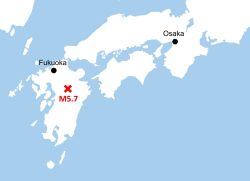
M5.7 Earthquake Hits Japan’s Kumamoto Pref., Measuring Upper 5 Intensity, No Tsunami Expected
JN ACCESS RANKING
-

Keidanren Chairman Yoshinobu Tsutsui Visits Kashiwazaki-Kariwa Nuclear Power Plant; Inspects New Emergency Safety System
-

Imports of Rare Earths from China Facing Delays, May Be Caused by Deterioration of Japan-China Relations
-

University of Tokyo Professor Discusses Japanese Economic Security in Interview Ahead of Forum
-

Japan Pulls out of Vietnam Nuclear Project, Complicating Hanoi’s Power Plans
-

Govt Aims to Expand NISA Program Lineup, Abolish Age Restriction




